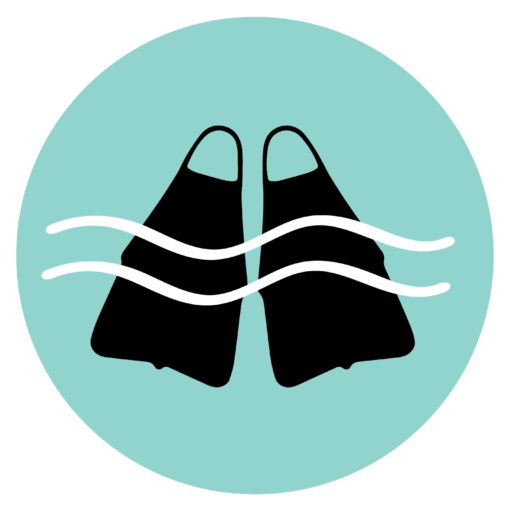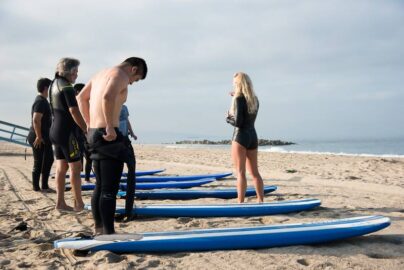As a surf instructor, I know the thrill of riding waves and the joy that comes from sharing that experience with students. Yet it wasn’t until recently that I fully grasped the importance of bodysurfing for surf instruction.
I am a former surf instructor and Red Cross lifeguard and NOLS-certified Wilderness First Responder. I’ve taught surfing for a variety of international surf retreats including Rustic Pathways and Surf with Amigas. Additionally, I was a head surf instructor at UCLA’s Marina Aquatic Center in 2017.
Adding bodysurfing to my teaching toolkit has greatly enhanced my connection with both the ocean and my surf students. Bodysurfing is a valuable tool for surf instructors to elevate their teaching game, improve ocean awareness, and create a deeper connection with their students.
Understanding Bodysurfing
There’s no doubt that surfing is the most glamorous wave-riding pastime. But its older sister, bodysurfing, is an ancient water sport that involves riding waves without the use of a board. It’s a pure and unadulterated form of wave riding where the surfer uses their body to glide along the face of the wave.
Bodysurfing has a rich history and cultural significance as a water sport. Its roots date back to ancient Polynesian and Hawaiian cultures, as well as West Africa and South America where it was considered a form of art and expression.
Unlike traditional surfing, which requires a surfboard and various techniques to stand up and ride, bodysurfing relies solely on the body’s positioning, movement, and relationship with the water. Bodysurfing is celebrated for its simplicity, purity, and connection with the ocean’s raw power.
Benefits for Surf Instructors

Enhanced Ocean Awareness
Bodysurfing requires a deep understanding of ocean dynamics, including wave formation, bottom contours, currents, and tides. This practice enhances your ability to assess surf conditions and make informed decisions about student safety, allowing instructors to teach with greater precision and confidence.
Bodysurfing improves our ability to:
- Use rising swells to our advantage
- Keep eye contact with the waves behind us at all times
- Feel the currents and the water movement between the sets and lulls
- Improve confidence swimming past the breakers
Improved Teaching Techniques
Bodysurfing can provide valuable insights into the mechanics of wave-riding. Instructors must communicate the importance of body positioning and weight distribution, as well as timing, in order for students to actually catch a wave on their own.
Bodysurfing is also fun! It makes surf instruction enjoyable in the white water since it provides instructors an opportunity for wave-riding, even in shallow water.
When surf instructors have fun it helps them relate to their students on a personal level, build trust, and foster a sense of camaraderie. This leads to increased student motivation and a more positive learning environment. It also shows surf students that all types of surfing are, and should be, fun!
Ultimately, as surfers progress out of the white water, bodysurfing allows instructors to confidently traverse the intermediate zone, taking students closer to the outside zone and allowing them to practice paddling, turtling, and even catching small green waves.
Increased Adaptability
Teaching anything in the ocean requires instructors and students to be adaptable and responsive to changing wave conditions. Bodysurfing is the perfect plan B, and teaching students how to do it is a necessary part of a surf instructor’s toolkit.
Understanding the art of bodysurfing is like having a secret weapon up your sleeve to teach students a new skill, in case surfing is too difficult for whatever reason. Bodysurfing is useful when conditions have deteriorated (too windy, high tide, etc.) in order to have a productive lesson.
At Bodhi Surf + Yoga we use bodysurfing as a way to introduce students to wave-riding and provide them with an essential safety skill.
Case Study: How to deal with a king tide during a surf lesson
The best case scenario is that your surf school plans lessons around tides to always ensure optimal surf conditions. However, tides and swells are constantly shifting and there are other logistics that get in the way of good timing. There are countless times I arrived at the beach with students and had to adapt to what was on offer.
Yet there is one week that sticks out in my mind when the conditions were literally un-surfable for beginners. My colleague Spencer Dunlap and I had four beginner surfers for a week of lessons in Costa Rica. They were surfing very well in the white water, but for the last lesson the high tide was SO high that the water was surging up the beach and into the jungle, dragging logs, sticks, and coconuts around, and swirling them in a mixed-up soup of backwash.
The students had learned enough that week to identify the less-than-stellar surfing conditions, so we brought out some Slyde Handboards and went for a swim. Dodging the logs and debris became a lot easier without a surfboard.
This sunset bodysurf session turned out to be one of the most memorable surf classes I ever taught. We all caught and shared long, fun waves, swimming and playing in the rhythmic currents and connecting to the ocean in a way board surfing doesn’t often evoke for new surfers.
Incorporating bodysurfing into your skill set can elevate your teaching game and create a more fulfilling and impactful experience for yourself as an instructor and your students.
Health and Fitness Benefits
Bodysurfing is a physically demanding activity that can also provide surf instructors with health and fitness benefits. Swimming, diving, and navigating through waves, improves cardiovascular fitness, strength, endurance, and overall water confidence.
Surf instructors who are physically fit and comfortable in the water can lead by example and inspire their students to develop healthy and active lifestyles.
Further, bodysurfing cultivates mindfulness. This is a flow state activity in which your mind becomes focused, and everything else falls away. There’s a connection that comes from being present in the water, feeling the currents beneath your body, and sensing your breath synchronizing with rising and falling waves.
This mind-ocean connection serves instructors by helping them navigate the ocean calmly in the case of an emergency or stressful situation with students.
What Bodysurfing Can Do For You

They say you’ll never work a day in your life if you do what you love. As someone who has been working as a surf instructor for the last ten years, sometimes, it still feels like work.
For me, bodysurfing is a way to reconnect to the reason I love teaching surfing in the first place—spending time in the ocean. It also allows me to play and have fun in the white water and gives my students a break from constant encouragement or criticism.
I believe that by modeling a deeper relationship with the ocean during a surf lesson, I am truly doing my best work, which is to convey the beauty and importance of connecting with the natural environment.
Most importantly, surf instructors are responsible for more than their own students. As trained water professionals, it is also our moral obligation to keep an eye on nearby swimmers and beachgoers, alerting them to any potential dangers, and making a rescue if necessary.
Having a pair of bodysurf fins with you during your surf lesson, and knowing how to use them, has lifesaving implications for those around you, making it a crucial skill to learn for any surf instructor.
Written by Carly Stoenner.


